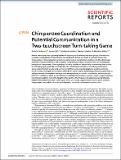Files in this item
Chimpanzee coordination and potential communication in a two-touchscreen turn-taking game
Item metadata
| dc.contributor.author | Voinov, Pavel V. | |
| dc.contributor.author | Call, Josep | |
| dc.contributor.author | Knoblich, Günther | |
| dc.contributor.author | Oshkina, Marina | |
| dc.contributor.author | Allritz, Matthias | |
| dc.date.accessioned | 2020-02-26T14:30:03Z | |
| dc.date.available | 2020-02-26T14:30:03Z | |
| dc.date.issued | 2020-02-25 | |
| dc.identifier | 266337699 | |
| dc.identifier | e7422104-632c-41f2-92f5-e6873a1faefe | |
| dc.identifier | 000563228900005 | |
| dc.identifier | 85096080232 | |
| dc.identifier.citation | Voinov , P V , Call , J , Knoblich , G , Oshkina , M & Allritz , M 2020 , ' Chimpanzee coordination and potential communication in a two-touchscreen turn-taking game ' , Scientific Reports , vol. 10 , 3400 . https://doi.org/10.1038/s41598-020-60307-9 | en |
| dc.identifier.issn | 2045-2322 | |
| dc.identifier.other | ORCID: /0000-0002-8597-8336/work/69835132 | |
| dc.identifier.uri | https://hdl.handle.net/10023/19539 | |
| dc.description | This research was supported by the European Research Council under the European Union's Seventh Framework Program (FP7/2007-2013) / ERC grant agreement n° [609819], SOMICS. | en |
| dc.description.abstract | Recent years have seen a growing interest in the question of whether and how groups of nonhuman primates coordinate their behaviors for mutual benefit. On the one hand, it has been shown that chimpanzees in the wild and in captivity can solve various coordination problems. On the other hand, evidence of communication in the context of coordination problems is scarce. Here, we investigated how pairs of chimpanzees (Pan troglodytes) solved a problem of dynamically coordinating their actions for achieving a joint goal. We presented five pairs of chimpanzees with a turn-taking coordination game, where the task was to send a virtual target from one computer display to another using two touch-screens. During the joint practice of the game some subjects exhibited spontaneous gesturing. To address the question whether these gestures were produced to sustain coordination, we introduced a joint test condition in which we simulated a coordination break-down scenario: subjects appeared either unwilling or unable to return the target to their partner. The frequency of gesturing was significantly higher in these test trials than in the regular trials. Our results suggest that at least in some contexts chimpanzees can exhibit communicative behaviors to sustain coordination in joint action. | |
| dc.format.extent | 13 | |
| dc.format.extent | 1770871 | |
| dc.language.iso | eng | |
| dc.relation.ispartof | Scientific Reports | en |
| dc.subject | BF Psychology | en |
| dc.subject | NDAS | en |
| dc.subject.lcc | BF | en |
| dc.title | Chimpanzee coordination and potential communication in a two-touchscreen turn-taking game | en |
| dc.type | Journal article | en |
| dc.contributor.sponsor | European Research Council | en |
| dc.contributor.institution | University of St Andrews. Centre for Social Learning & Cognitive Evolution | en |
| dc.contributor.institution | University of St Andrews. School of Psychology and Neuroscience | en |
| dc.identifier.doi | https://doi.org/10.1038/s41598-020-60307-9 | |
| dc.description.status | Peer reviewed | en |
| dc.date.embargoedUntil | 2020-02-25 | |
| dc.identifier.grantnumber | 609819 | en |
This item appears in the following Collection(s)
Items in the St Andrews Research Repository are protected by copyright, with all rights reserved, unless otherwise indicated.

